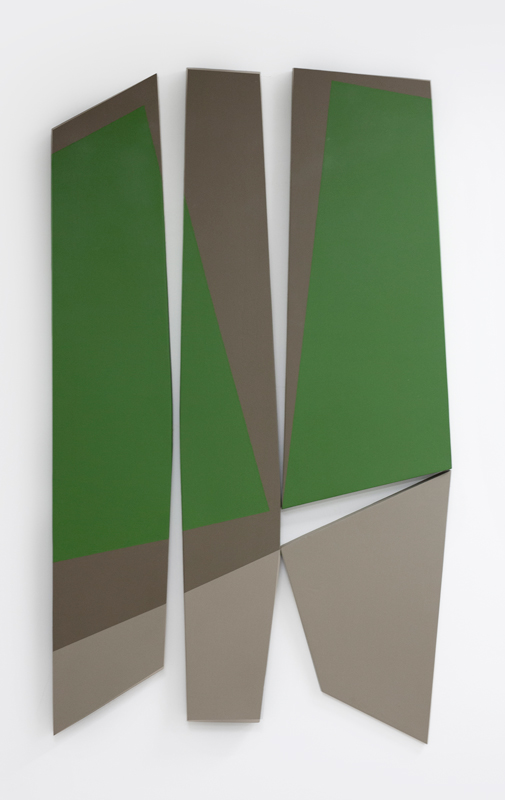
5 minute read
Brazilian-Born Artist Fabiana Salomão
Illuminating New Possibilities
Emitting boundless creativity through diverse concepts in modern art
Brazilian-born Fabiana Salomão first visited Canada in 1999 and established a deep connection with the country immediately. She has returned every other year since then. In 2018, she decided to spend more time here in Canada. Seeking new experiences, she set up a home and studio in Toronto, bringing with her over 20 years of experience in visual arts and literature.

Salomão’s work spans paintings, installations, photo, and video performance. Her abstract works stem from her research into Modernist influences like Bauhaus and the Concrete Art and Neo-Concretism movements, which continue to shape contemporary art, design, and architecture.
When speculating how other artists found their path, she wondered if it was as clearcut a direction as her own. “For me, it was like a sudden awakening, an epiphany,” she says. “I vividly recall the moment when it felt like a new world opened up before me, as if I had gained a third-eye vision into the realm of the art universe. It was like a new dimension of possibility.”

Frequently poring over books around the age of six in her grandfather’s home library, she searched for figures, which were then elusive in stacks of books with no illustrations. “Time and time again, I was there trying to find any sign of images,” she recalls. “One day, I stumbled upon a collection of magazines about the greatest painters. I can still feel the momentum when I opened the first edition. It was a book about Almeida Junior, a very famous Brazilian painter.”
Three of the paintings she came upon were “Saudade” (Longing, 1890), “Reading” (1892), and “The Inopportune” (1898); those first few minutes for Salomao affected her deeply. “I remember thinking, ‘It exists.’” By that meaning, her mind’s eye had been affirmed: art exists. Afterwards, she searched for art everywhere she went: walls, books, and sculptures.

As a “self-taught explorer,” she began to draw and experiment with mediums. “Throughout my childhood and teenage years, I surrounded myself with self-learning, waiting for the time when I would grow up and be able to go to university to learn ‘properly.’”
Salomao attended the Universidade Belas Artes in São Paulo, Brazil to pursue an art degree, and also received her Bachelor’s degree in Fine Arts and Literature at Estácio University. After formally graduating in 1994, she went on to work in the publishing industry for three decades, and continues to work as both illustrator and creative art director for several publishers in Brazil as well as internationally. “I’ve dedicated nearly 20 years to art production as well,” she notes.
Modernism and its reverberation in Contemporary Art is the foundation of Salomao’s work and is formed through her affection for form and shapes and dimensions expressed in acrylic on wood, her favourite medium.

One of the legacies of Modernism she finds most meaningful is its emphasis on simplicity and functionality and “the idea of creating spaces that were efficient, minimalist, and in harmony with their surroundings,” she says. “Moreover, Modernism encouraged a rethinking of societal norms and conventions, leading to a greater emphasis on individuality and self-expression. This shift towards personal autonomy and creative freedom has permeated various aspects of contemporary life, from fashion and interior design to personal relationships and cultural expression.”
Each of Salomao’s pieces are deeply rooted in the tradition of Bauhaus, which she explains was influenced by the European Modernist architects and artists who migrated to Central and South America during the Second World War and influenced Brazilian art. “To understand my production, one must navigate through the intricate history of concrete art and its various offshoots, such as Neo-Concretism, which emerged in Brazil. Neo-Concretism, particularly in the 1960s, expanded the Concrete notion of art beyond the confines of the canvas, emphasizing interaction with the public.”

She explains that her artistic practice is not confined to a single form, as the concept of Neo-Concrete influenced her tremendously. “I constantly study and try to embrace the multifaceted nature of concrete art and its evolution, drawing inspiration from the rich tapestry of influences that have shaped Latin American art history. By carrying forward this legacy, I seek to contribute to the ongoing dialogue surrounding art, design, and architecture, rooted in my very personal way in the contemporary style.”
Currently, you can view Salomao’s work at Abbozzo Gallery, and at her upcoming show, Bossa in House, opening July 12th at Abbozzo Gallery and Bossa, a pop-up show in Port Carling, July 20 and 21.

Salomao continues to grow, learn and spark with ideas. “Just as friction sparks a match, challenges and experiences fuel my creative process, illuminating new possibilities,” she says. “I believe that creativity has the power to transform lives, even if only for a fleeting moment, by generating light and inspiration that radiate outward, sparking further innovation and growth.” To Salomao, this captures the belief in “the transformative power of creativity and the immense potential that resides within each individual, waiting to be unleashed and shared with the world. This aligns with the idea that creativity has the power to transcend barriers and transform both individuals and society.”
For more info, follow @FabianaSalomao and visit AbbozzoGallery.com










